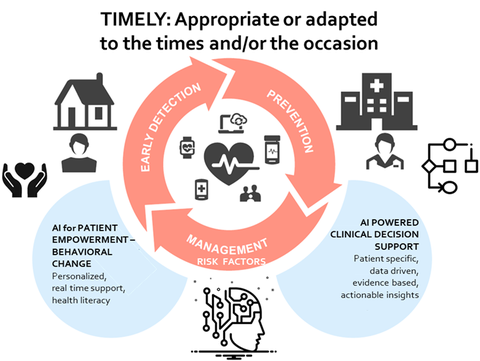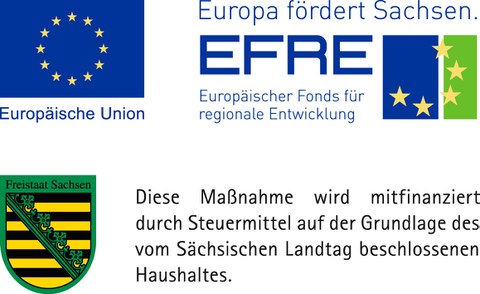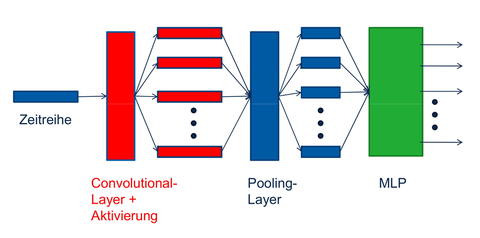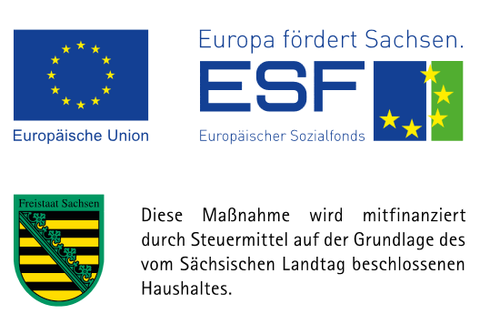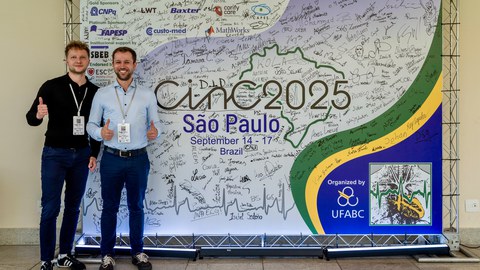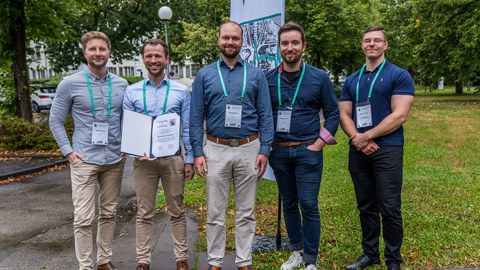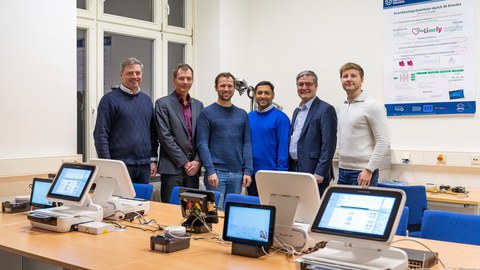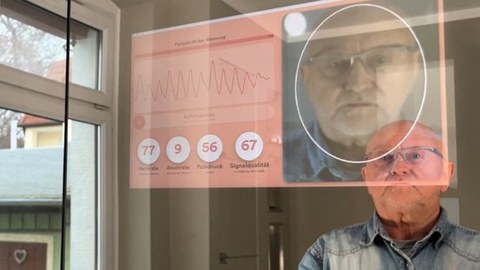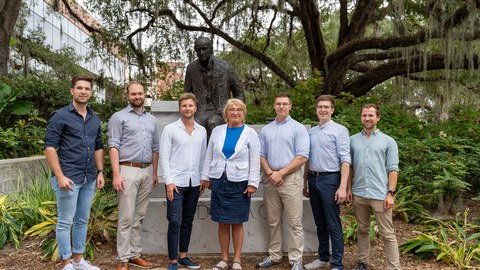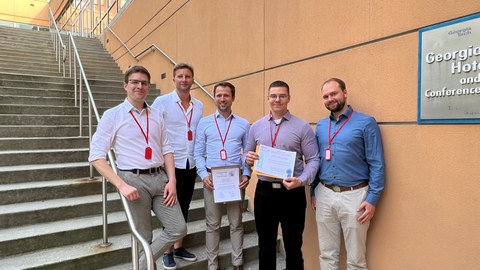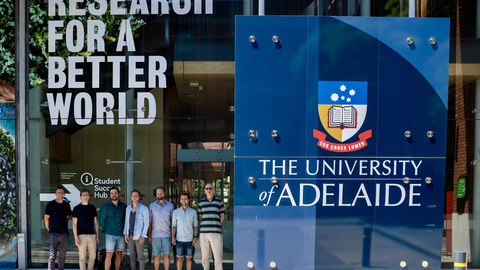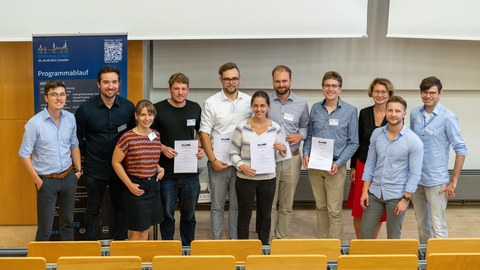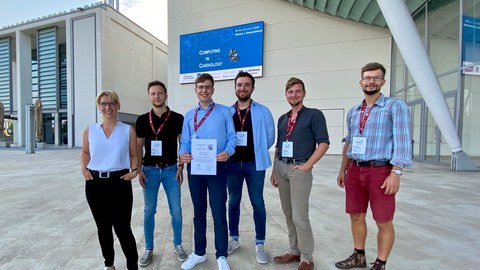Biosignal Processing Group
Table of contents
Overview
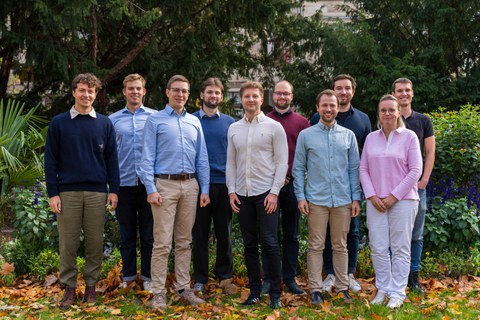
Our group in fall 2025: L. Girschick, L. Seliger, H. Ernst-Völker, J. Müller, M. Schmidt, R. Hohmuth, A. Hammer, M. Scherpf, N. Wäßnig und M. Zannini (from left to right).
Our group is working on the development of innovative new methods for the analysis of biosignals in order to improve today's diagnostic and therapeutic procedures as well as provide new medical technology solutions.
We work together with clinical and non-clinical partners, from the research and industry field, in national and international projects. Such projects cover all areas from basic research to clinical trials and application-oriented developments.
Application of implemented procedures and systems can be found in the clinical area, e.g. in cardiology, intensive care, sleep medicine and prenatal medicine. Moreover, our group addresses forward-looking out-of-hospital and non-medical applications, e.g. Ambient Assisted Living and sport monitoring.
Our contribution to MDR aktuell “Medicine of tomorrow”: Diagnosis from the mirror (English subtitles available). © Report from the ARD theme day “Medicine of tomorrow” from 09.04.2024 on MDR television.
Collaboration
Anyone interested in project, study, and master theses (ET, INF, MT, WING), research projects (INF, CMS) or student assistant activities has the opportunity to work on the research topics and current projects of the group at any time. Specific inquiries are addressed to Dr. Martin Schmidt (contact below).
Selected Projects
Coronary artery disease (CAD) remains the leading cause of disease burden globally. CAD develops slowly, usually over decades, and depends on multiple (often modifiable) risk factors and their interactions. Self-management and patient activation are of rising importance as current restrictions in healthcare budgets impose great difficulties to enable the provision of qualitative secondary prevention to all cardiac patients in an era facing a huge cardiovascular disease epidemic.
The main hypothesis in the patient-centered TIMELY pathway, is that a modular, collaborative eHealth platform, supported by Artificial Intelligence (AI) for the continuous and in-time prediction of cardiac risks and complications and the induction of targeted behavioural change interventions, can be effective and cost-efficient for the secondary prevention of CAD by limiting the physiological and psychological effects of the disease and improving risk factor and symptom management. Improvements in patients’ self-care and empowerment and clinicians’ efficiency are also expected.
Along the continuum of the disease, prediction of the individual risk for disease progression, including physical impairment and severe events, is mandatory for timely intervention. TIMELY is a platform that provides AI-powered apps and dashboards and decision support tools assisting patients and clinicians to personalize healthcare based on risk evaluation, outcome prediction and tailored interventions. The platform will be developed based on a functional platform for Interoperability with electronic health records and security mechanisms, to ensure information completeness and continuity and to simplify data sharing. AI in TIMELY, built with big retrospective datasets of >23.000 CAD patients, will constantly monitor and evaluate risks and will indicate any deviation from defined therapy goals or unfavorable changes as well as propose proper interventions.
This project has received funding from the European Union’s Horizon 2020 Research and Innovation Programme under Grant agreement ID: 101017424. Further informations can be found at the website of the project.
By evaluating the color channels of an RGB camera, it is possible to record certain physiological parameters when recording selected areas of skin. These include, for example, the heart rate. Camera-based photoplethysmography has already been researched at the Institute for several years. The following publications can be consulted for more detailed information.
-
H. Ernst, M. Scherpf, S. Pannasch, J. R. Helmert, H. Malberg, and M. Schmidt, ‘Assessment of the human response to acute mental stress–An overview and a multimodal study’, PLOS ONE, vol. 18, no. 11, p. e0294069, Nov. 2023, doi: 10.1371/journal.pone.0294069.
-
Ernst, H. Malberg, and M. Schmidt, ‘Automatic Detection of Acute Mental Stress With Camera-based Photoplethysmography’, in 2023 Computing in Cardiology (CinC), Oct. 2023, pp. 1–4. doi: 10.22489/CinC.2023.034.
-
M. Scherpf, H. Malberg, and M. Schmidt, ‘Improved Pulse Pressure Estimation Based on Imaging Photoplethysmographic Signals’, in 2022 Computing in Cardiology (CinC), Sep. 2022, pp. 1–4. doi: 10.22489/CinC.2022.307.
-
H. Ernst, H. Malberg, and M. Schmidt, ‘Non-contact Measurement of Respiration Rate with Camera-based Photoplethysmography During Rest and Mental Stress’, in 2022 Computing in Cardiology (CinC), Sep. 2022, pp. 1–4. doi: 10.22489/CinC.2022.219.
-
M. Scherpf, H. Ernst, L. Misera, H. Malberg, and M. Schmidt, “Skin Segmentation for Imaging Photoplethysmography Using a Specialized Deep Learning Approach,” in 2021 Computing in Cardiology (CinC), Sep. 2021, pp. 1–4. doi: 10.23919/CinC53138.2021.9662682.
-
H. Ernst, M. Scherpf, H. Malberg, and M. Schmidt, “Optimal color channel combination across skin tones for remote heart rate measurement in camera-based photoplethysmography,” Biomedical Signal Processing and Control, vol. 68, p. 102644, Jul. 2021, doi: 10.1016/j.bspc.2021.102644.
-
M. Scherpf, H. Ernst, H. Malberg, and M. Schmidt, ‘DeepPerfusion: Camera-based Blood Volume Pulse Extraction using a 3D Convolutional Neural Network’, in Computing in Cardiology 2020, Rimini, 2020. doi: 10.22489/CinC.2020.388.
- S. Zaunseder, A. Trumpp, D. Wedekind, and H. Malberg, “Cardiovascular assessment by imaging photoplethysmography - a review,” (eng), Biomedizinische Technik. Biomedical engineering, vol. 63, no. 5, pp. 617–634, 2018.
-
A. Trumpp et al., ‘Camera-based photoplethysmography in an intraoperative setting’, BioMedical Engineering OnLine, vol. 17, no. 1, p. 33, Mar. 2018, doi: 10.1186/s12938-018-0467-7.
-
A. Trumpp et al., ‘Skin Detection and Tracking for Camera-Based Photoplethysmography Using a Bayesian Classifier and Level Set Segmentation’, in Bildverarbeitung für die Medizin 2017, geb. F. Maier-Hein Klaus Hermann, geb. L. Deserno Thomas Martin, H. Handels, and T. Tolxdorff, Eds., in Informatik aktuell. Springer Berlin Heidelberg, 2017, pp. 43–48.
- S. Rasche et al., ‘Camera-based photoplethysmography in critical care patients’, Clinical Hemorheology and Microcirculation, vol. 64, no. 1, pp. 77–90, Jan. 2016, doi: 10.3233/CH-162048.
The autonomic nervous system (ANS) controls numerous body functions and shows specific reactions depending on personal conditions. The assessment of the ANS allows extensive statements, for example on the risk of suffering life-threatening illnesses, an assessment of sleep and the recording of stress levels.
Our group is developing novel methods of signal processing in order to be able to make such statements. In addition to the currently established analysis of heart rate variability, we focus at novel measures e.g. the QT interval variability. For their evaluation, innovative approaches have been and are being developed. The aim is a substantial improvement of the diagnostic possibilities, in particular the prediction and prevention, without creating an additional burden for the patients.
As part of the project, a close cooperation is maintained with the group of Prof. Mathias Baumert (The University of Adelaide). More information about the project can be found on the website of Two-Dimensional Signal Warping (2DSW).

Schematic representation of the two-dimensional signal warping algorithm (siehe auch http://2dsw.com/).
Publications
-
M. Schmidt, M. Baumert, T. Penzel, H. Malberg, und S. Zaunseder, „Nocturnal ventricular repolarization lability predicts cardiovascular mortality in the Sleep Heart Health Study“, American Journal of Physiology-Heart and Circulatory Physiology, Bd. 316, Nr. 3, S. H495–H505, Dez. 2018, doi: 10.1152/ajpheart.00649.2018.
-
M. Schmidt, M. Baumert, H. Malberg, und S. Zaunseder, „T Wave Amplitude Correction of QT Interval Variability for Improved Repolarization Lability Measurement“, Front. Physiol., Bd. 7, 2016, doi: 10.3389/fphys.2016.00216.
-
M. Schmidt, M. Baumert, H. Malberg, und S. Zaunseder, „Iterative two-dimensional signal warping—Towards a generalized approach for adaption of one-dimensional signals“, Biomedical Signal Processing and Control, Bd. 43, S. 311–319, Mai 2018, doi: 10.1016/j.bspc.2018.03.016.
-
M. Schmidt, M. Baumert, A. Porta, H. Malberg, und S. Zaunseder, „Two-Dimensional Warping for One-Dimensional Signals—Conceptual Framework and Application to ECG Processing“, IEEE Transactions on Signal Processing, Bd. 62, Nr. 21, S. 5577–5588, Nov. 2014, doi: 10.1109/TSP.2014.2354313.
The aim of the project is to develop innovative systems and procedures for patient monitoring, which already consider user-friendliness and patient comfort as core aspects alongside functionality during the design and development phase. The core component is the contactless measurement technology used to record vital parameters. This is to be integrated into the home environment both physically and in terms of information technology. Through age-appropriate application and interaction options and the connection to the information structure at home, a new generation of medical technology is to be developed that reduces barriers on the user side, significantly increases patient acceptance and comfort and thus lays the foundation for efficient self-management at home.
Our contribution to MDR aktuell “Medicine of tomorrow”: Diagnosis from the mirror (English subtitles available). © Report from the ARD theme day “Medicine of tomorrow” from 09.04.2024 on MDR television.
Especially in sleep medicine, but also in non-clinical applications, the evaluation of sleep quality plays a crucial role. In this context, the Machine Learning group is engaged with the automated classification of sleep stages, the detection of sleep-related breathing and sleep disorders and the automated derivation of recommendations for action. Modern methods of pattern recognition, machine learning (ML) and artificial intelligence (AI) are applied.
In the context of the research project Teleschlafmedizin, the research group is developing a telemedical platform for sleep medicine together with partners from the clinic and industry. The project comprises three main development focuses:
- Advancement, adaptation and validation of contactless medical measurement technologies for sleep medicine applications.
- Integration of various diagnostic and therapeutic biosignals and data from sleep medicine in a medical database (data integration). This concerns polysomnographic data from the clinic for neurology as well as monitoring data from the home environment.
- Development of a telemedical system that uses AI methods in order to automate data analysis and thus render it simpler and more practical.
The project is funded by the European Regional Development Fund (EFRE).
The goal of the ESF junior research group MEDICOS (Medical Implant Communication System) is the development of extremely energy-efficient, compact and adaptive communication and biosignal processing systems, and thus the creation of a technical basis for a new generation of intelligent implants:
- New system concepts for risk prediction and prevention
- Implant networking and better data connection
- Powerful data processing strategies
- Long service life due to high energy efficiency
The project is granted by the European Social Fund (ESF) and from tax revenue on the basis of the budget approved by the members of the Landtag of the Free State of Saxony.
The aim of the fast athletics project is to optimize the biomechanical and sport physiological real-time performance diagnostics in recreational and professional sports for the movement-controlled self-education process and for the broadcast through the integration of
- novel body-near sensor infrastructures and control principles and
- novel training methods for sensory perception and motion control.

Schematic representation of the biofeedback in rowing planned in the project.
The project addresses the technical and sports physiological fundamentals (methods, systems, knowledge) of a real-time physiological biofeedback (focus on real-time electromyogram, real-time EMG) in order to optimize the training with sport-related cyclically executed movements, such as rowing, cross country skiing or cycling. For this purpose, a prototypical realization for the rowing ergometer is implemented and evaluated.
Cluster members:
Further informations can be found at the website of the project
Fetal monitoring is currently limited in various ways. Consequently, there is a special need for non-invasive and simple methods that can be applied over longer periods, ideally also outside the clinic. Solutions eventually provide the needed all-day applications.

Extraction of fetal ECG and fetal heartbeats (fQRS).
The fetal electrocardiogram (fECG), obtained through abdominal electrodes, is a method which tackles those problems. Therefore, electrical signals are recorded from electrodes placed on the belly of the mother. The signals contain the maternal ECG, fECG and noise. The separation of those signals is still mainly the subject of research.
This problem of source separation was addressed in the research group on an internationally high level. This success is particularly evident in two first places in the Computing in Cardiology Challenge 2013. Further research results on simulation, extraction and quality assessment of fetal ECG data were combined in a toolbox (FECGSYN).

Device technology for the acquisition of the fetal ECG.
Since 2018, work has been taking place within the DFG project "Enhanced Fetal Monitoring". A large database of longitudinal recordings during pregnancy is being established in cooperation with the University Hospital Leipzig and the Humbold University Berlin.
The focus of future work includes the development of innovative algorithms extract the fECG and do further research on characteristics of the fECG itself. In addition, we test novel fECG based markers to identify fetal development and predict pregnancy complications. Overall, we seek to develop new fetal monitoring techniques and systems.
Publications

Sponsord by the German Research Foundation
- J. Weiß, H. Malberg, und M. Schmidt, „Detection Quality Indices for Improved Heart Beat Assessment in Non-Invasive Fetal ECG“, in 2020 Computing in Cardiology, Sep. 2020, S. 1–4, doi: 10.22489/CinC.2020.231.
-
F. Andreotti, F. Gräßer, H. Malberg, und S. Zaunseder, „Non-invasive Fetal ECG Signal Quality Assessment for Multichannel Heart Rate Estimation“, IEEE Transactions on Biomedical Engineering, Bd. 64, Nr. 12, S. 2793–2802, Dez. 2017, doi: 10.1109/TBME.2017.2675543.
-
J. Behar, F. Andreotti, S. Zaunseder, J. Oster, und G. D. Clifford, „A practical guide to non-invasive foetal electrocardiogram extraction and analysis“, Physiol. Meas., Bd. 37, Nr. 5, S. R1–R35, Apr. 2016, doi: 10.1088/0967-3334/37/5/R1.
-
F. Andreotti, J. Behar, S. Zaunseder, J. Oster, und G. D. Clifford, „An open-source framework for stress-testing non-invasive foetal ECG extraction algorithms“, Physiol. Meas., Bd. 37, Nr. 5, S. 627–648, Apr. 2016, doi: 10.1088/0967-3334/37/5/627.
Special Teams
Awards
| Award: | 2nd Place Best Paper Award |
| Event: | Workshop Biosignale 2020, Kiel |
| Contribution: | Farbräume und Gesichtsbereiche zur kamerabasierten Herzratenschätzung |
| Award winners/authors: | Hannes Ernst, Matthieu Scherpf, Hagen Malberg, Martin Schmidt |
| Award: | 3rd Place Best Paper Award |
| Event: | Workshop Biosignale 2020, Kiel |
| Contribution: | Einsatz von Spektroskopie in der multispektralen Photoplethysmographie |
| Award winners/authors: | Richard Hohmuth, Hagen Malberg, Martin Schmidt |
| Award: | Rosanna Degani Young Investigator Award (semi-finalist) |
| Event: | Computing in Cardiology 2020, Rimini |
| Contribution: | More Reliable Remote Heart Rate Measurement by Signal Quality Indexes |
| Award winners/authors: | Hannes Ernst, Hagen Malberg, Martin Schmidt |
| Award: | 1st Place Best Presentation Award |
| Event: | Workshop Biosignale 2022, Dresden |
| Contribution: | Optimierung der kamerabasierten Photoplethysmographie für die kontaktlose Messung kardiovaskulärer Parameter |
| Award winners/authors: | Hannes Ernst, Hagen Malberg, Martin Schmidt |
| Award: | 3rd Place Best Presentation Award |
| Event: | Workshop Biosignale 2022, Dresden |
| Contribution: | Influence of Cardiovascular Diseases on the Coupling Behavior Between Central and Autonomic Nervous System |
| Award winners/authors: | Richard Hohmuth, Alexander Hammer, Hagen Malberg, Martin Schmidt |
| Award: | Rosanna Degani Young Investigator Award (semi-finalist) |
| Event: | Computing in Cardiology 2023, Atlanta |
| Contribution: | Cardiovascular Reflections of Sympathovagal Imbalance Precede the Onset of Atrial Fibrillation |
| Award winners/authors: | Alexander Hammer, Hagen Malberg, Martin Schmidt |
| Award: | 2nd Place Hackathon PhysioNet Challenge |
| Event: | Computing in Cardiology 2023, Atlanta |
| Award winners/authors: | Richard Hohmuth, Marc Göttling, Maurice Rohr |
| Award: | Rosanna Degani Young Investigator Award (semi-finalist) |
| Event: | Computing in Cardiology 2024, Karlsruhe |
| Contribution: | Morphology Features Self-Learned by Explainable Deep Learning for Atrial Fibrillation Detection Correspond to Fibrillatory Waves |
| Award winners/authors: | Alexander Hammer, Hagen Malberg, Martin Schmidt |
Partner
Our group works together with numerous partners from research and industry. This also includes close cooperation with several clinics.
Several international collaborations have been initiated and established in recent years, for example with the University of Adelaide (Australia) ord the Florida State University (USA). Industrial cooperations have been established with companies including BIOTRONIK SE & Co. KG and Sonovum GmbH.
Researchers
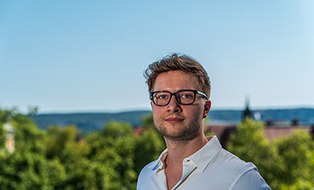
Research Group Leader
NameMr Dr.-Ing. Martin Schmidt
Biosignal Processing Group
Send encrypted email via the SecureMail portal (for TUD external users only).
Visiting address:
Fetscherforum (F29), 1st Floor , Room 34 Fetscherstraße 29
01307 Dresden

Postdoctoral Researcher | KOMVITAL
NameMr Dr.-Ing. Hannes Ernst-Völker
Biosignal Processing Group
Send encrypted email via the SecureMail portal (for TUD external users only).
Visiting address:
Fetscherforum (29), 1st Floor, Room 33 Fetscherstraße 29
01307 Dresden

Doctoral Student
NameMr Dipl.-Ing. Marc Göttling
Biosignal Processing Group
Send encrypted email via the SecureMail portal (for TUD external users only).
Visitor Address:
Fetscherforum (29), 1st Floor, Room 33 Fetscherstraße 29
01307 Dresden
None

Doctoral Student | ecgXfusion
NameMr Dipl.-Wi.-Ing. Alexander Hammer
Biosignal Processing Group
Send encrypted email via the SecureMail portal (for TUD external users only).
Visiting address:
Fetscherforum (29), 1st Floor, Room 31 Fetscherstraße 29
01307 Dresden
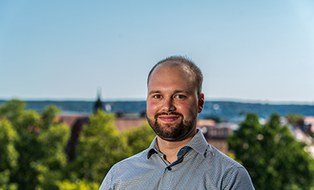
Doctoral Student
NameMr Dipl.-Ing. Richard Hohmuth
Biosignal Processing Group
Send encrypted email via the SecureMail portal (for TUD external users only).
Visitor Address:
Fetscherforum (29), 1st Floor, Room 31 Fetscherstraße 29
01307 Dresden
None

Doctoral Student | KOMVITAL
NameMr Dipl.-Ing. Matthieu Scherpf
Biosignal Processing Group
Send encrypted email via the SecureMail portal (for TUD external users only).
Visitor Address:
Fetscherforum (F29), 1st Floor, Room 32 Fetscherstr. 29
01307 Dresden
None
Clinical Scientist | ecgXfusion
NameMs Dr. med. Nadine Wäßnig
Biosignal Processing Group
Send encrypted email via the SecureMail portal (for TUD external users only).
Visiting address:
Fetscherforum (29), 1. OG, Raum 30 Fetscherstraße 29
01307 Dresden
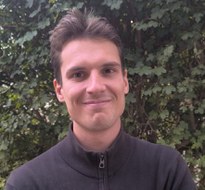
Doctoral Student
NameMr Matteo Zannini M.Sc.
Biosignal Processing Group
Send encrypted email via the SecureMail portal (for TUD external users only).
Visiting address:
Fetscherforum (29), 1. OG, Raum 31 Fetscherstraße 29
01307 Dresden
Recent Publications
2024
-
Einsatz von KI in der Medizin aus Sicht der biomedizintechnischen Forschung, Nov 2024, In: Ärzteblatt Sachsen. 35, 11, p. 27-31Electronic (full-text) versionResearch output: Contribution to journal > Letter
-
An explainable AI for trustworthy detection of atrial fibrillation on reduced lead ECGs in mobile applications, 28 Oct 2024, In: European heart journal. 45, Suppl 1, ehae666.3497Electronic (full-text) versionResearch output: Contribution to journal > Research article
-
Evaluation der KI-gestützten Arousal-Detektion auf der Basis von Schlaflabordaten im Vergleich zu öffentlichen Schlaflabordaten: Resultierende Empfehlungen für die Anwendung in der wissenschaftlichen Praxis, Oct 2024, p. S10, 1 p.Electronic (full-text) versionResearch output: Contribution to conferences > Abstract
-
State-of-the-art sleep arousal detection evaluated on a comprehensive clinical dataset, 14 Jul 2024, In: Scientific reports. 14, 1, 16239Electronic (full-text) versionResearch output: Contribution to journal > Research article
-
xECGArch: a trustworthy deep learning architecture for interpretable ECG analysis considering short-term and long-term features, 7 Jun 2024, In: Scientific Reports. 14, 1, 13122Electronic (full-text) versionResearch output: Contribution to journal > Research article
-
Novel Metric for Non-Invasive Beat-to-Beat Blood Pressure Measurements Demonstrates Physiological Blood Pressure Fluctuations during Pregnancy, 15 May 2024, In: Sensors. 24, 10, 3151Electronic (full-text) versionResearch output: Contribution to journal > Research article
-
Cardiovascular Diseases Inhibit the Activation of Cardio-Cerebral Coupling During Arousals, 2024, 4 p.Electronic (full-text) versionResearch output: Contribution to conferences > Paper
-
Detecting Atrial Fibrillation from Reduced-Lead Electrocardiograms of Mobile Patches Using Interpretable Features, 2024, In: Computing in Cardiology. 51, p. 1-4Electronic (full-text) versionResearch output: Contribution to journal > Conference article
-
Influence of Autonomic Nervous System Activity on Cerebral Autoregulation in Traumatic Brain Injury, 2024, In: Computing in Cardiology. 51, 4 p.Electronic (full-text) versionResearch output: Contribution to journal > Conference article
-
Morphology Features Self-Learned by Explainable Deep Learning for Atrial Fibrillation Detection Correspond to Fibrillatory Waves, 2024, In: Computing in Cardiology. 51, p. 1-4, 4 p.Electronic (full-text) versionResearch output: Contribution to journal > Conference article


